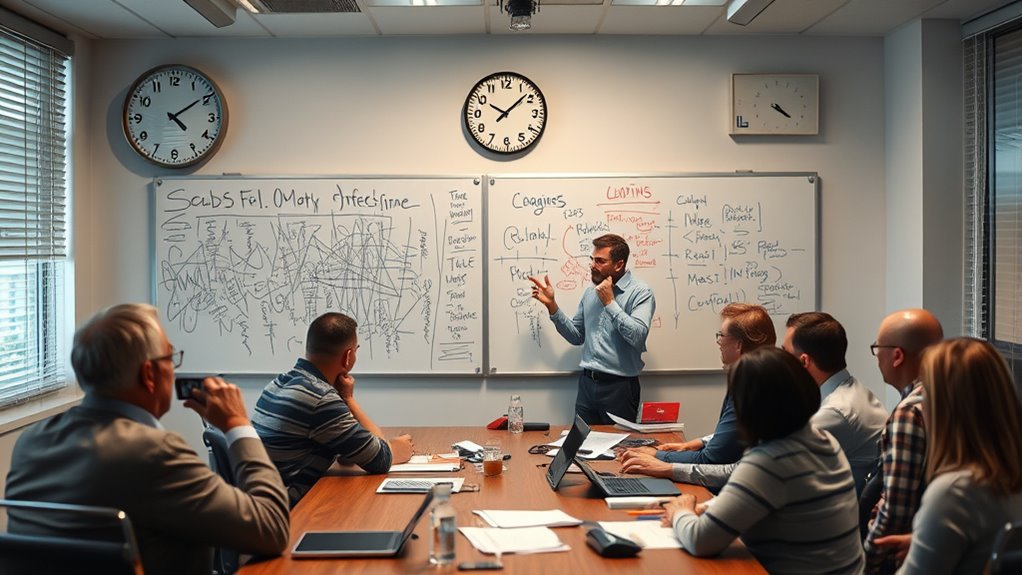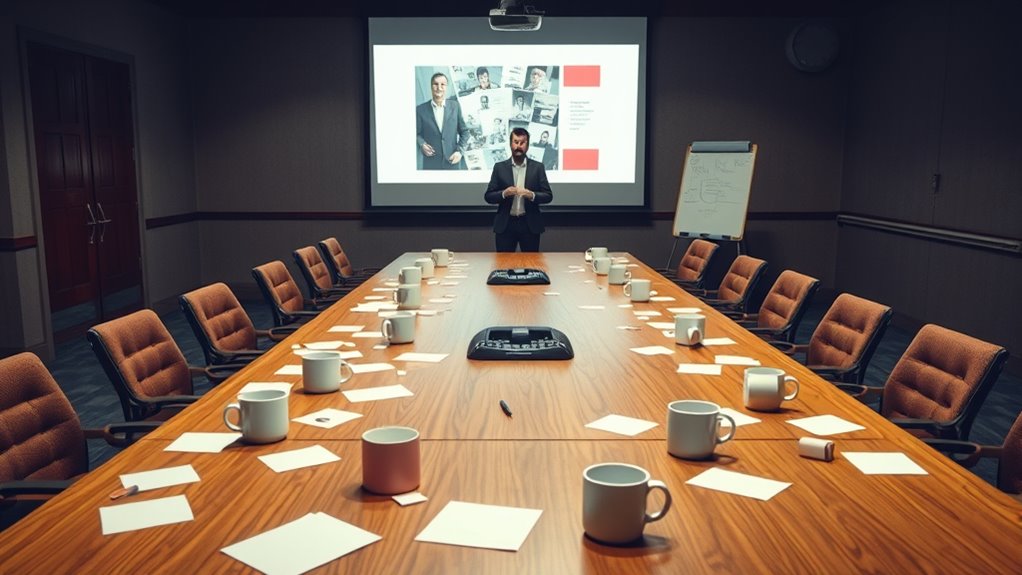Even experienced facilitators often make common mistakes that undermine their sessions. These include overloading agendas, which can cause overwhelm, and failing to actively engage all participants, leaving others disengaged. Poor time management, dominance by a few voices, and neglecting cultural differences can also disrupt flow and inclusivity. Not preparing properly or skipping follow-up can prevent goals from being achieved. Stay tuned—exploring these pitfalls more deeply can help you avoid them and run more effective facilitation.
Key Takeaways
- Common facilitation mistakes include poor agenda management, inadequate preparation, and losing focus during sessions.
- Engaging all participants and managing dynamics like dominance or silence are crucial for inclusive facilitation.
- Time management and pacing directly impact session flow and participant engagement.
- Recognizing and adapting to cultural and communication differences enhances inclusivity and effectiveness.
- Even experienced facilitators can struggle with balancing participation, maintaining focus, and managing session flow.
Overloading the Agenda

When you try to cover too many topics in a single meeting, you risk overwhelming participants and sacrificing depth for breadth. This is known as agenda overload, where trying to address everything at once leads to topic saturation. When the agenda is packed, attendees may become disengaged or confused, making it hard to focus on key issues. You might rush through important points or leave discussions half-finished, reducing overall effectiveness. To prevent this, stick to a clear, prioritized agenda that highlights the most critical topics. Limit the number of items and allocate sufficient time for each. Additionally, incorporating focused content can help maintain clarity and ensure that key points are thoroughly addressed. This way, you ensure meaningful conversations, foster engagement, and promote better decision-making without overburdening your team.
Failing to Engage All Participants

Are all participants truly contributing during your meetings? If not, you’re missing out on valuable insights and risking disengagement. Failing to engage all participants often happens when you rely on a few voices or neglect inclusive strategies. Using interactive techniques like small-group discussions, polls, or round-robin sharing can boost participant inclusivity. These methods ensure everyone has a voice, preventing dominant personalities from overshadowing quieter members. By intentionally designing activities that invite input from all, you create an environment where diverse perspectives thrive. Remember, a successful facilitation isn’t just about delivering information—it’s about fostering active involvement. When you prioritize participant inclusivity with thoughtful engagement strategies, you’ll see richer conversations and more committed participation from everyone in the room. Additionally, understanding the importance of legal representation can help ensure all voices are heard when navigating complex processes.
Ignoring Time Management

When you ignore time management, your session can easily run over or finish too early, frustrating participants. Overestimating how long activities take or neglecting to stick to your agenda disrupts the flow. Disregarding participant pace only adds to the chaos, making it harder to achieve your objectives. Incorporating effective content discoverability strategies ensures your session remains engaging and well-paced.
Overestimating Session Duration
Overestimating session duration can derail an otherwise productive meeting by leaving little time for discussion or follow-up. When you misjudge the session length estimation, you risk running over time or rushing vital topics. Proper time buffer planning helps accommodate unforeseen delays, ensuring the meeting stays on track. Instead of overly stretching the schedule, set realistic time limits for each agenda item, and include buffer periods to handle unexpected issues. This approach prevents sessions from becoming too lengthy or too rushed, maintaining engagement and focus. Remember, accurate time management isn’t just about fitting everything in; it’s about giving your team enough space to contribute meaningfully while respecting everyone’s schedule. Effective session duration planning keeps your meetings efficient, purposeful, and better aligned with your objectives. Additionally, understanding the importance of time management can help prevent common facilitation mistakes and improve overall session outcomes.
Neglecting Agenda Timing
Neglecting agenda timing can quickly undermine even well-planned meetings. When you misjudge how long discussions will take, it leads to time misjudgment and agenda overlook. Overestimating or underestimating time causes sessions to run over or rush through important topics, frustrating participants and reducing productivity. Failing to allocate appropriate time slots means key issues might be skipped or inadequately addressed. Keeping track of time ensures each item gets proper attention and the meeting stays on schedule. If you ignore time management, you risk derailment and disengagement. Effective facilitators monitor progress closely, adjusting as needed. Remember, respecting agenda timing isn’t just about punctuality; it’s about maintaining focus, balancing discussion, and achieving your meeting’s objectives efficiently. Incorporating techniques like time management can help prevent these pitfalls and keep your meetings on track.
Disregarding Participant Pace
Do you consider how quickly or slowly your participants speak and process information during meetings? Ignoring their pace can lead to disengagement or rushed discussions. Pacing adjustments are essential to keep everyone engaged and ensure meaningful participation. Pay close attention to participant feedback—are people struggling to keep up, or are they losing interest because things are dragging? If you notice signs of impatience or confusion, adapt your approach by slowing down or speeding up certain segments. Failing to do so may cause some members to feel overlooked or overwhelmed. Effective facilitation involves actively managing the group’s pace, not just sticking rigidly to your schedule. By tuning into participant cues and making pacing adjustments, you create a more inclusive and productive environment. Incorporating time management strategies helps facilitators maintain an optimal flow throughout the session.
Dominating the Conversation

When a few participants dominate the conversation, others may feel ignored or hesitant to share their ideas. Over-talking can drown out quieter members, making the discussion less balanced. Addressing these issues helps create a more inclusive environment where everyone’s input matters. Incorporating auditory feedback therapy techniques can also help individuals become more aware of their speaking patterns and improve overall communication dynamics.
Over-Talking Participants
Over-talking participants can derail a productive discussion by dominating the conversation and preventing others from sharing their perspectives. When someone consistently talks over others, it discourages silent participation, which is essential for balanced dialogue. As a facilitator, your role is to encourage active listening, prompting quieter members to contribute. If one person dominates, others may feel sidelined or reluctant to speak up. To address this, gently steer the conversation back to inclusivity by asking open-ended questions or directly inviting quieter participants to share their thoughts. Remember, a healthy discussion relies on balance—ensuring everyone’s voice is heard helps prevent over-talking and fosters a more collaborative environment. Being aware of participant dynamics is crucial for maintaining productive and equitable conversations. Your awareness of these dynamics keeps the conversation productive and equitable.
Ignoring Quiet Members
Ignoring quiet members can silently undermine the effectiveness of a discussion by allowing a few voices to overshadow others. When you overlook silent participation, introverted members may feel excluded or hesitant to share their insights. This not only limits diverse perspectives but also discourages valuable contributions from those who prefer listening or reflecting. By focusing only on outspoken participants, you risk creating an environment where only the loudest voices are heard, leaving quieter members behind. Recognizing the importance of silent participation helps foster an inclusive space where everyone feels comfortable contributing. As a facilitator, you need to actively invite input from introverted members, ensuring they have opportunities to share without feeling pressured. This balanced approach strengthens the discussion and uncovers insights that might otherwise remain hidden. Attention in creative practice can play a significant role in ensuring all members are engaged and valued.
Dominance by Few
Dominance by a few participants can quickly derail a productive discussion, as a handful of voices overshadow others and limit diverse input. This imbalance skews power dynamics, making it harder for the group to reach well-rounded decisions. When a few individuals dominate the conversation, it suppresses quieter members’ contributions, reducing the quality of decision making. As a facilitator, you need to recognize these patterns early and intervene to ensure balanced participation. Encourage quieter members to share their perspectives, set time limits for speakers, and actively manage the flow of discussion. Addressing dominance helps create an environment where all voices are valued, leading to better decisions and a more inclusive process. Remember, a balanced conversation fosters richer insights and more effective outcomes. Monitoring group dynamics can help you spot early signs of dominance and take corrective action.
Not Preparing Adequately

When facilitators fail to prepare adequately, they risk undermining the entire session before it even begins. Preparation pitfalls often lead to unclear objectives, leaving participants confused about the purpose. Without a solid plan, agenda misalignments occur, making discussions unfocused or off-track. You might overlook key materials or fail to anticipate questions, wasting valuable time. This can cause frustration and diminish engagement. Proper prep involves reviewing content, understanding participant needs, and setting clear goals. Skipping these steps leaves you reactive rather than proactive, increasing the likelihood of disruptions. Remember, thorough preparation guarantees you control the flow, foster participation, and achieve meaningful outcomes. Neglecting this step signals a lack of professionalism and can sabotage the success of your facilitation efforts.
Overlooking Cultural and Communication Differences

Failing to account for cultural and communication differences can quickly derail a facilitation session that’s already off track due to poor preparation. Cultural nuances influence how participants express ideas, interpret feedback, and engage in discussions. Overlooking these differences can lead to misunderstandings, misinterpretations, and even offense. Language barriers further complicate communication, causing participants to struggle with clarity or feel excluded. You might assume everyone shares the same communication style or background, but that’s rarely the case. To avoid these pitfalls, it’s essential to recognize and adapt to diverse cultural norms and language needs. This awareness fosters respect, encourages open dialogue, and ensures all voices are heard. Addressing these differences upfront helps create a more inclusive, effective facilitation environment.
Neglecting Follow-Up and Action Items

Neglecting follow-up and action items can undermine the progress made during a facilitation session and cause issues to resurface later. When you skip follow-up strategies, accountability lapses occur, making it easier for tasks to fall through the cracks. Without clear responsibilities and deadlines, participants may forget or delay their commitments, hindering momentum. To prevent this, you need to establish concrete follow-up plans immediately after the session, such as setting reminders or check-in meetings. Regularly tracking progress keeps everyone accountable and ensures action items are addressed promptly. Ignoring this step risks losing the benefits of the facilitation, allowing problems to persist or worsen. Effective follow-up is essential to turn insights into tangible results and sustain the positive change you aim to achieve.
Losing Focus or Straying Off-Topic

Have you ever noticed how easy it is for a meeting to drift off course or for discussions to veer away from the main topic? Distraction triggers like side conversations, personal anecdotes, or even your own wandering thoughts can cause focus shift. When this happens, you might find yourself chasing tangents instead of addressing the core issue. To prevent losing focus, keep the agenda clear and gently steer the conversation back when it strays. Recognize early signs of focus drift and address them quickly. Using visual cues or time checks can help maintain the flow. Staying vigilant about distraction triggers ensures meetings stay productive and on-topic, saving everyone’s time and energy.
Frequently Asked Questions
How Can I Measure the Success of a Facilitation Session?
To measure the success of a facilitation session, you should focus on feedback mechanisms and participant engagement. Ask for immediate feedback through surveys or open discussions to gauge understanding and satisfaction. Observe how actively participants engage in discussions and activities. High engagement and positive feedback indicate your session was effective. Regularly reviewing these indicators helps you improve future sessions, ensuring they meet your goals and resonate with your audience.
What Tools Can Help Manage Facilitation Challenges Effectively?
This question is a game-changer for your facilitation success! You can leverage interactive tools like digital polling or collaborative platforms to keep participants engaged and streamline discussions. Feedback methods such as real-time surveys or post-session evaluations help you identify challenges and improve. These tools act like a secret weapon, transforming your facilitation into a smooth, impactful experience where every challenge becomes an opportunity for growth and connection.
How Do I Handle Disruptive or Uncooperative Participants?
When dealing with disruptive or uncooperative participants, focus on maintaining participant engagement by actively listening and addressing concerns calmly. Use conflict resolution techniques like redirecting the conversation or setting clear ground rules. Stay composed, avoid escalation, and involve the group in finding solutions. This approach helps manage disruptions effectively, keeps the session productive, and fosters a positive environment where everyone feels heard and respected.
What Are Signs of Ineffective Facilitation During a Session?
Imagine a workshop where participants start disengaging halfway through. Signs of ineffective facilitation include unclear objectives, causing confusion, and participant disengagement, leading to less interaction. If you notice attendees zoning out, avoiding eye contact, or drifting off-topic, it indicates you’re not guiding effectively. You might also struggle to keep discussions focused or fail to encourage participation. Recognizing these signs helps you adjust your approach to re-engage your audience.
How Do I Adapt Facilitation for Virtual Versus In-Person Meetings?
When adapting facilitation for virtual versus in-person meetings, you need to tailor your approach. For virtual adaptation, use interactive tools like polls and chat to engage participants. In in-person strategies, focus on body language and group dynamics. You’ll want to balance technology use with face-to-face interaction, ensuring all voices are heard. Adjust your timing and activities to suit each setting, making sure your facilitation remains effective and engaging regardless of the format.
Conclusion
Even seasoned facilitators make mistakes—like overloading agendas or neglecting cultural nuances—that can derail a session. Did you know that 70% of meetings are perceived as unproductive? To keep your sessions effective, stay prepared, manage time wisely, and engage everyone. Remember, avoiding common pitfalls isn’t just about smooth facilitation; it’s about ensuring your team stays motivated and aligned. Keep learning and refining your skills to lead truly impactful meetings.









